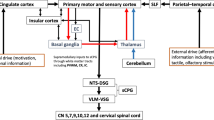Abstract
Thalamus.The human thalamus is a nuclear complex located in the diencephalon and comprising of four parts (the hypothalamus, the epythalamus, the ventral thalamus, and the dorsal thalamus). The thalamus is a relay centre subserving both sensory and motor mechanisms. Thalamic nuclei (50–60 nuclei) project to one or a few well-defined cortical areas. Multiple cortical areas receive afferents from a single thalamic nucleus and send back information to different thalamic nuclei. The corticofugal projection provides positive feedback to the "correct" input, while at the same time suppressing irrelevant information. Topographical organisation of the thalamic afferents and efferents is contralateral, and the lateralisation of the thalamic functions affects both sensory and motoric aspects. Symptoms of lesions located in the thalamus are closely related to the function of the areas involved. An infarction or haemorrhage thalamic lesion can develop somatosensory disturbances and/or central pain in the opposite hemibody, analgesic or purely algesic thalamic syndrome characterised by contralateral anaesthesia (or hypaesthesia), contralateral weakness, ataxia and, often, persistent spontaneous pain.
Basal ganglia.Basal ganglia form a major centre in the complex extrapyramidal motor system, as opposed to the pyramidal motor system (corticobulbar and corticospinal pathways). Basal ganglia are involved in many neuronal pathways having emotional, motivational, associative and cognitive functions as well. The striatum (caudate nucleus, putamen and nucleus accumbens) receive inputs from all cortical areas and, throughout the thalamus, project principally to frontal lobe areas (prefrontal, premotor and supplementary motor areas) which are concerned with motor planning. These circuits: (i) have an important regulatory influence on cortex, providing information for both automatic and voluntary motor responses to the pyramidal system; (ii) play a role in predicting future events, reinforcing wanted behaviour and suppressing unwanted behaviour, and (iii) are involved in shifting attentional sets and in both high-order processes of movement initiation and spatial working memory. Basal ganglia-thalamo-cortical circuits maintain somatotopic organisation of movement-related neurons throughout the circuit. These circuits reveal functional subdivisions of the oculomotor, prefrontal and cingulate circuits, which play an important role in attention, learning and potentiating behaviour-guiding rules. Involvement of the basal ganglia is related to involuntary and stereotyped movements or paucity of movements without involvement of voluntary motor functions, as in Parkinson’s disease, Wilson’s disease, progressive supranuclear palsy or Huntington’s disease. The symptoms differ with the location of the lesion. The commonest disturbances in basal ganglia lesions are abulia (apathy with loss of initiative and of spontaneous thought and emotional responses) and dystonia, which become manifest as behavioural and motor disturbances, respectively.
Similar content being viewed by others
Author information
Authors and Affiliations
Additional information
Electronic Publication
Rights and permissions
About this article
Cite this article
Herrero, MT., Barcia, C. & Navarro, J. Functional anatomy of thalamus and basal ganglia. Childs Nerv Syst 18, 386–404 (2002). https://doi.org/10.1007/s00381-002-0604-1
Received:
Published:
Issue Date:
DOI: https://doi.org/10.1007/s00381-002-0604-1




